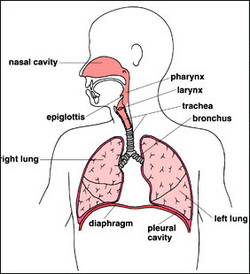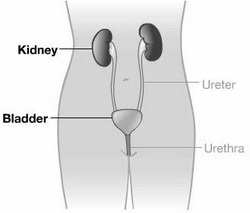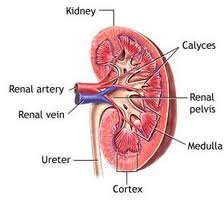Chapter 20
Respiration and Excretion
The Respiratory System

Courtesy of University of Maryland Medical Center
Breathing is the movement of the chest that brings air into the lungs and removes waste gases. The oxygen you inhale is needed in the cells to make energy. Glucose and oxygen make energy, water, and carbon dioxide, so when you exhale, you are getting rid of carbon dioxide and water.
Air enters your body through the nostrils or the mouth. When you breathe through your nose, your nose hairs warm, moisten, and filter the air. Then the air passes through the nasal cavity, where mucus traps extra materials that were not trapped by your nose hairs. Cilia are tiny hairlike structures that sweep these materials to the back of the thoroat, where thay are swallowed.
The pharynx is at the back of the throat, and connects the mouth and nose. At the end of the phharynx is the epiglottis, a flap of tissue that covers your airway to prevent food or drinks from going down it. This way the food will go down the esophagus.
The larynx comes after the pharynx. The larynx has the vocal cords, which allow you to talk, sing, and make noise.
The trachea is after the larynx. It is about 12 cm long, and has mucus membranes that trap dust and other materials that shouldn't be there.
The trachea splits into two bronchi at the end. The bronchi get smaller and smaller, until they become bronchioles. At the end of all of the bronchioles are clusters of alveoli, or tiny, thin-walled sacs. These sacs fill with oxygen, and the oxygen diffuses through the walls and into the capillaries. Carbon dioxide also diffuses from the capillaries into the alveoli to be exhaled.
There are many diseases of the respiratory system. Some examples are the flu, the common cold, bronchitis, chronic bronchitis, emphysema, lung cancer, and asthma. Most of these are easier to get when you smoke. Smoking causes you to catch many diseases easier.
Air enters your body through the nostrils or the mouth. When you breathe through your nose, your nose hairs warm, moisten, and filter the air. Then the air passes through the nasal cavity, where mucus traps extra materials that were not trapped by your nose hairs. Cilia are tiny hairlike structures that sweep these materials to the back of the thoroat, where thay are swallowed.
The pharynx is at the back of the throat, and connects the mouth and nose. At the end of the phharynx is the epiglottis, a flap of tissue that covers your airway to prevent food or drinks from going down it. This way the food will go down the esophagus.
The larynx comes after the pharynx. The larynx has the vocal cords, which allow you to talk, sing, and make noise.
The trachea is after the larynx. It is about 12 cm long, and has mucus membranes that trap dust and other materials that shouldn't be there.
The trachea splits into two bronchi at the end. The bronchi get smaller and smaller, until they become bronchioles. At the end of all of the bronchioles are clusters of alveoli, or tiny, thin-walled sacs. These sacs fill with oxygen, and the oxygen diffuses through the walls and into the capillaries. Carbon dioxide also diffuses from the capillaries into the alveoli to be exhaled.
There are many diseases of the respiratory system. Some examples are the flu, the common cold, bronchitis, chronic bronchitis, emphysema, lung cancer, and asthma. Most of these are easier to get when you smoke. Smoking causes you to catch many diseases easier.
The Excretory System

Courtesy of Science Rules
The excretory system rids your body of wastes. One of these systems is the urinary system. The urinary system allows your body to get rid of wastes, excess water, acids, alcohol, excess salts, sugars, bases, and nutrients. The nutrients and water are mostly reabsorbed.
The main organs of the urinary system are the kidneys. Every person has 2, except if something happened to one. Kidneys filter the blood. Inside the kidneys are about 1,250,000 nephrons, or tiny filtering units. The blood goes into the kidneys through the renal arteries. It then goes into the nephrons, where it goes into the glomerulus. The glomerulus is inside the Bowman's Capsule. It gets filtered, and the wastes go into a collecting duct. The collecting duct empties into the renal pyramid, which leads to the ureters. They lead to the urinary bladder, which holds the wastes (now called urine) until they are ready to be excreted through the urethra.
When somebody's kidney doesn't work, they can have a kidney transplant. If both kidneys fail, a person can get dialysis, which is when a machine filters the blood, and does what the kidneys would usually do.
The main organs of the urinary system are the kidneys. Every person has 2, except if something happened to one. Kidneys filter the blood. Inside the kidneys are about 1,250,000 nephrons, or tiny filtering units. The blood goes into the kidneys through the renal arteries. It then goes into the nephrons, where it goes into the glomerulus. The glomerulus is inside the Bowman's Capsule. It gets filtered, and the wastes go into a collecting duct. The collecting duct empties into the renal pyramid, which leads to the ureters. They lead to the urinary bladder, which holds the wastes (now called urine) until they are ready to be excreted through the urethra.
When somebody's kidney doesn't work, they can have a kidney transplant. If both kidneys fail, a person can get dialysis, which is when a machine filters the blood, and does what the kidneys would usually do.

